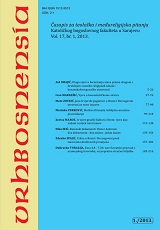Ezra 4,8 - 7,26: novi hrvatski prijevod s aramejskog izvornika, uz popratne stručne bilješke
Ezra 4:8 – 7:26: A new translation from the original Aramaic, followed by an analysis and short commentary
Author(s): Dubravko TuralijaSubject(s): Christian Theology and Religion
Published by: Katolički bogoslovni fakultet
Keywords: First Temple period; Second Temple period; Israel-Judean monarchy; Solomon; Zedekiah; Babylonian exile; Nebuchadnezzar; Darius I; Judea; Jewish- Roman War; Book of Ezra; Mosaic Law; Book of Nehemiah; Aramaic; Xerxes; Artaxerxes; Sheshbazzar; Tattenai
Summary/Abstract: The classical Judean historical era is divided into the First and Second Temple periods. The First Temple period is tied to the Israel-Judean monarchy which was founded by Solomon (David) and which lasted until the reign of the last Judean king, Zedekiah, and the Babylonian exile in 586 B.C. following the destruction of the Temple by Nebuchadnezzar. The Second Temple period is marked by the reconstruction of Solomon’s Temple under the Persian king, Darius I, in 516 B.C. This period includes the return of the Jews from Babylonian captivity, the reconstruction of the Temple and the hierarchical socio-religious establishment in Judea. The Second Temple period ended with the First Jewish-Roman War and the destruction of the Temple in 70 A.D. The Book of Ezra, characterized by its bilingualism, is focused on the return of the Jews from exile (Hebrew, Chapters 1 – 3), the reconstruction of the Temple in Jerusalem (Aramaic, Chapters 4 – 5), the establishment of the social community in Judea (Aramaic, Chapter 6) and the implementation of Mosaic Law by the Jewish returnees (Aramaic-Hebrew, Chapters 7 – 10). Although the Book of Ezra is traditionally associated with the Book of Nehemiah, it seems that these two books, regardless of their similarities, were created independently of each other. The Aramaic text of the Book of Ezra deals in particular with the situation in Jerusalem after the reign of King Darius (486 B.C.). The Aramaic narration begins with problems regarding the local gentiles and Jewish returnees from exile (4:6-24). The kings who played important roles in the reconstruction of Jerusalem, in the Aramaic chapters, are Xerxes (486-465 B.C.) and Artaxerxes (465-424 B.C.). In addition to these, the Persian vassals Sheshbazzar and Tattenai, rulers of the Trans-Euphrates territory or the Province Beyond the River, occupy a remarkable place in the Aramaic narration, especially the Aramaic dialogues with the Persian kings (cf. Ezra 4 – 6). In Ezra 6:6-12, Tattenai is linked with King Darius, although chronologically this passage appears to be an elaboration of an earlier document issued during the rule of King Cyrus in 538 B.C., which shows that the Persian Empire respected the law and statutes of local conquered peoples, including the people of Judea. This new Croatian translation of the Aramaic section of the Book of Ezra is accompanied by concise morphological-syntactical study notes and commentary. The article deals exclusively with the Aramaic text, comparing key words with those in the Akkadian and Hebrew languages. Our goal has been to render a faithful translation of the Aramaic part of the Book of Ezra (4:8 – 7:26) into the Croatian language, following the biblical original, and comparing it to existing translations by Antun Sović, Ivan Evanđelista Šarić and Silvije Grubišić.
Journal: Vrhbosnensia
- Issue Year: 2013
- Issue No: 1
- Page Range: 183-216
- Page Count: 34
- Language: Croatian

